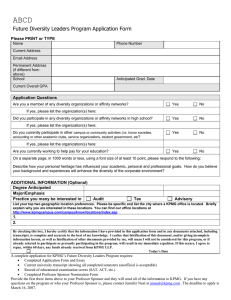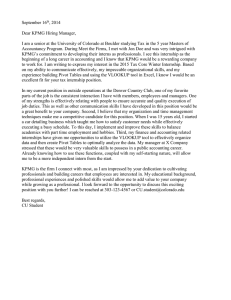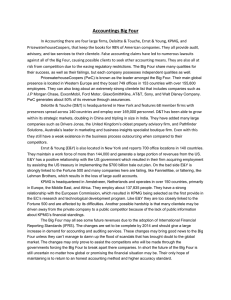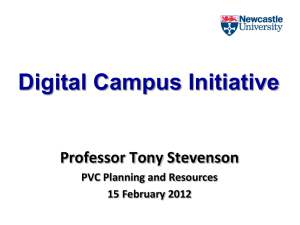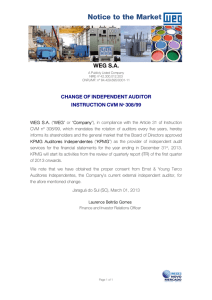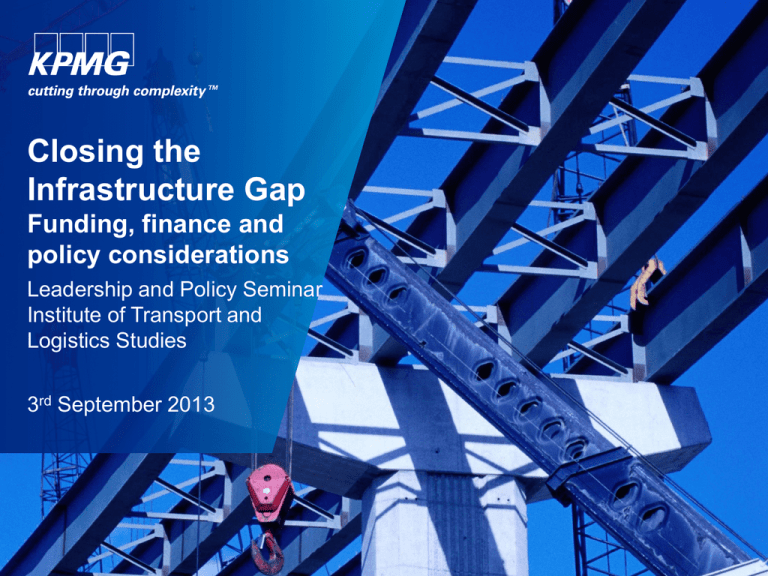
Closing the
Infrastructure Gap
Funding, finance and
policy considerations
Leadership and Policy Seminar
Institute of Transport and
Logistics Studies
3rd September 2013
Disclaimer
The information contained herein is of a general nature and is not intended to address the
circumstances of any particular individual or entity. Although we endeavour to provide accurate
and timely information, there can be no guarantee that such information is accurate as of the
date it is received or that it will continue to be accurate in the future. No one should act on such
information without appropriate professional advice after a thorough examination of the particular
situation.
The views and opinions expressed herein are those of the presenter and do not necessarily
represent the views and opinions of KPMG, an Australian partnership, part of the KPMG
International network.
© 2013 KPMG, an Australian partnership and a member firm of the KPMG network of independent member firms affiliated with KPMG International
Cooperative (“KPMG International”), a Swiss entity. All rights reserved.
KPMG and the KPMG logo are registered trademarks of KPMG International.
1
Where are we today?
Australia’s population has grown rapidly and will continue to do so …
Australian Population
Millions
40
35
30
25
CAGR 1946-2007 = 1.7%
20
15
10
5
0
1946 1956 1966 1976 1986 1996 2006 2016 2026 2036 2046
Range
Historical
Projected
Source: ABS
© 2013 KPMG, an Australian partnership and a member firm of the KPMG network of independent member firms affiliated with KPMG International
Cooperative (“KPMG International”), a Swiss entity. All rights reserved.
KPMG and the KPMG logo are registered trademarks of KPMG International.
2
Where are we today?
… and road traffic & road freight volumes have also grown strongly …
Travel by road
Billions
250
CAGR 1998-2010 = 2.5%
200
150
CAGR 1998-2010 = 4.0%
100
50
0
1998 1999 2000 2001 2002 2003 2004 2005 2006 2007 2008 2009 2010
Total km, all vehicles
Total freight tonne-km
Source: BITRE
© 2013 KPMG, an Australian partnership and a member firm of the KPMG network of independent member firms affiliated with KPMG International
Cooperative (“KPMG International”), a Swiss entity. All rights reserved.
KPMG and the KPMG logo are registered trademarks of KPMG International.
3
Where are we today?
… as they have for rail, too
Travel by rail
Billions
16
14
12
Billions
200
175
150
CAGR 1980-2009 = 1.8%
10
125
8
100
CAGR 1980-2008 = 4.1%
6
75
4
50
2
25
0
1980 1983 1986 1989 1992 1995 1998 2001 2004 2007
0
Passenger-km (lhs)
Freight tonne-km (rhs)
Source: BITRE
© 2013 KPMG, an Australian partnership and a member firm of the KPMG network of independent member firms affiliated with KPMG International
Cooperative (“KPMG International”), a Swiss entity. All rights reserved.
KPMG and the KPMG logo are registered trademarks of KPMG International.
4
Where are we today?
Most of us have experienced the consequences
M4 Motorway, Sydney
Sydney Harbour Bridge
Source: Daily Telegraph
Source: SBS
Wynyard Station, Sydney
Source: Sydney Morning Herald
Victoria Road, Sydney
Source: Sydney Morning Herald
© 2013 KPMG, an Australian partnership and a member firm of the KPMG network of independent member firms affiliated with KPMG International
Cooperative (“KPMG International”), a Swiss entity. All rights reserved.
KPMG and the KPMG logo are registered trademarks of KPMG International.
Source: Herald-Sun
5
Where are we today?
It’s not just our roads and railways that are congested
Queue of coal ships off Newcastle
Source: Newcastle Herald
© 2013 KPMG, an Australian partnership and a member firm of the KPMG network of independent member firms affiliated with KPMG International
Cooperative (“KPMG International”), a Swiss entity. All rights reserved.
KPMG and the KPMG logo are registered trademarks of KPMG International.
6
Where are we today?
Several major transport projects are underway or in development, but
the needs for more infrastructure are immense
• Various estimates of up to $770 billion over 10 years
• Access Economics has identified over $200 billion of planned
transport projects
• IA’s Priority List has over $80 billion of transport projects
• Many major projects have been on the drawing board for a long time
Melbourne Metro
NW Rail Link
Pacific Highway Upgrade
Source: Public Transport Victoria
Source: Transport for NSW
Source: Transport for NSW
© 2013 KPMG, an Australian partnership and a member firm of the KPMG network of independent member firms affiliated with KPMG International
Cooperative (“KPMG International”), a Swiss entity. All rights reserved.
KPMG and the KPMG logo are registered trademarks of KPMG International.
7
Can we afford such large sums?
Can we not afford them?
Traffic congestion has major socio-economic costs:
• Delay / time
• Trip variability
• Vehicle operating
expenses
• Motor vehicle
emissions
$ billion
25
Costs of congestion
20
Projected
15
10
5
0
1990 1994 1998 2002 2006 2010 2014 2018
Business vehicles
Private vehicles
Source: BITRE
Congestion costs of $15 billion (est.) in FY2013 were 1% of GDP!
© 2013 KPMG, an Australian partnership and a member firm of the KPMG network of independent member firms affiliated with KPMG International
Cooperative (“KPMG International”), a Swiss entity. All rights reserved.
KPMG and the KPMG logo are registered trademarks of KPMG International.
8
Infrastructure spending pays dividends!
Infrastructure spending has a multiplier effect on the economy
Estimates of the size of the multiplier vary:
• BITRE: 2.65×
• Access Economics: 1.69×
300
• OECD: 1.1–1.3×
250
200
Transport projects also have 150
strong benefit to cost ratios 100
• 1.2 – 10.5x
50
• Weighted average 1.8x
0
Infrastructure
spend
© 2013 KPMG, an Australian partnership and a member firm of the KPMG network of independent member firms affiliated with KPMG International
Cooperative (“KPMG International”), a Swiss entity. All rights reserved.
KPMG and the KPMG logo are registered trademarks of KPMG International.
Impact on GDP
9
Lack of available funding is the major constraint
Funding and financing are different things
Sources of funding for transport infrastructure
• Higher taxes
• Cuts in other Government expenditure
• Asset sales
• Higher Government debt
• User charges
• “Third sources”
We need:
• Government commitments to building up infrastructure funds
• Project prioritisation based on economic returns and productivity
© 2013 KPMG, an Australian partnership and a member firm of the KPMG network of independent member firms affiliated with KPMG International
Cooperative (“KPMG International”), a Swiss entity. All rights reserved.
KPMG and the KPMG logo are registered trademarks of KPMG International.
10
Asset sales are one way forward
Governments still own assets and provides services that would be
better in the private sector
• Such assets and services either compete directly with private sector
or are provided successfully by the private sector elsewhere
• Government risk aversion stifles innovation and entrenches
inefficiency
• Government ownership doesn’t always mean a better deal for
consumers – what matters is effective regulation
• Government ownership ties up scarce capital better used for new
infrastructure
© 2013 KPMG, an Australian partnership and a member firm of the KPMG network of independent member firms affiliated with KPMG International
Cooperative (“KPMG International”), a Swiss entity. All rights reserved.
KPMG and the KPMG logo are registered trademarks of KPMG International.
11
Why are a AAA credit rating and a surplus sacrosanct?
Governments can afford to spend more on infrastructure
• The benefits outweigh the costs
• We are a long way from a slippery slope to destitution
• No business targets a AAA rating
Source: AFP
© 2013 KPMG, an Australian partnership and a member firm of the KPMG network of independent member firms affiliated with KPMG International
Cooperative (“KPMG International”), a Swiss entity. All rights reserved.
KPMG and the KPMG logo are registered trademarks of KPMG International.
12
Commonwealth Government support
The States and Territories are responsible for most transport
infrastructure projects
Commonwealth support traditionally has been direct grants, which are
not ideal
Can link their provision to projects that:
• are nationally significant
• are consistent with Reform Agenda
• properly consider private sector
involvement
Need to consider co-funding
availability payments or other
operating period support
Gold Coast Rapid Transit, artist’s impression
Source: GoldLinQ
© 2013 KPMG, an Australian partnership and a member firm of the KPMG network of independent member firms affiliated with KPMG International
Cooperative (“KPMG International”), a Swiss entity. All rights reserved.
KPMG and the KPMG logo are registered trademarks of KPMG International.
13
User charges – a solution with problems
Recent projects have had a poor
success record
• over-optimistic patronage forecasts
• problematic procurement model
• lenders now won’t finance new
projects
Lane Cove Tunnel
Possible solutions:
Source: Sydney Morning Herald
• Availability Payments, funded by user charges received by
Government
• Minimum patronage guarantee from Government
© 2013 KPMG, an Australian partnership and a member firm of the KPMG network of independent member firms affiliated with KPMG International
Cooperative (“KPMG International”), a Swiss entity. All rights reserved.
KPMG and the KPMG logo are registered trademarks of KPMG International.
14
A third source of funding
Developer contributions to specific
projects can be substantial
• Chatswood Interchange
• Hong Kong airport railway
• London Crossrail and Northern
Line Battersea Extension
Chatswood Interchange
Source: Laing O’Rourke
Tax Increment Financing – borrowing against future increases in
income from rates
• considerable interest in US
• proposed for Northern Line Battersea Extension
© 2013 KPMG, an Australian partnership and a member firm of the KPMG network of independent member firms affiliated with KPMG International
Cooperative (“KPMG International”), a Swiss entity. All rights reserved.
KPMG and the KPMG logo are registered trademarks of KPMG International.
15
A call to action
• Regular and substantial Government contributions to an infrastructure
fund
• Follow through on the promise of Infrastructure NSW to take the
politics out of infrastructure provision
• Asset sales, to free up capital and reduce future funding needs
• Greater spending and debt, even if it means a lower credit rating
• More creative use of Commonwealth funding
• Don’t give up on “user pays” – but Government needs to mitigate
patronage risk
• Further explore “third sources” of funding such as developer
contributions and TIF
© 2013 KPMG, an Australian partnership and a member firm of the KPMG network of independent member firms affiliated with KPMG International
Cooperative (“KPMG International”), a Swiss entity. All rights reserved.
KPMG and the KPMG logo are registered trademarks of KPMG International.
16
Thank you
Presentation by:
David Asteraki
Director
Infrastructure & Projects Group
KPMG Corporate Finance
T: +61 2 9295 3858
M: +61 450 958348
E: dasteraki@kpmg.com.au
© 2013 KPMG, an Australia partnership and a
member firm of the KPMG network of independent
member firms affiliated with KPMG International
Cooperative (KPMG International), a Swiss entity. All
rights reserved.
The KPMG name, logo and ‘cutting through
complexity’ are registered trademarks or trademarks
of KPMG International Cooperative (KPMG
International).

